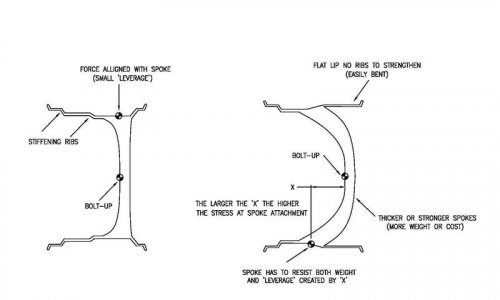"Quote:
Originally Posted by swerve
the area you call the 'back lip' is in fact the weakest part of the wheel"
""What makes you say this? What makes the backside of a wheel inherently the weakest? What if the face of the wheel was mounted to the barrel in such a way that it had only a 1/2" lip, leaving the front of the wheel with a 8" lip? That .5" lip is weakest? I think your statement is over-generalizing, or more likely, incorrect""
incorrect?
you are grasping straws- i am replying directly to your statement that "all wheels have 'back lips' so there should be no problem having one in the front".
i said that in fact the 'back lip' on a normal wheel is the weakest part and by adding additional lip on the front you are adding additional stress area. the further away you move from the bolt-up face, the stronger the 'moment arm' is acting on the material meaning it is easier to damage.
"Is a Volk GT-C with a +43 offset is stronger than a Volk GT-C with a +30 offset? Or is a Volk TE37 with a +43 offset is weaker than a Volk TE37 with a +30 offset?"
in fact yes, the offsets do make a difference in strength of a wheel.
most of the cast wheels out there are 'overdone' (hence heavy) to protect from damage to the product and litigation etc. you may not actually break the wheel during normal driving but that does not mean that it is not weaker. best test-lab is the racetrack- any lips there? need i say more?
unless you are a structural engineer (which i am) i am done arguing unless you want to put some money on it and then i'll run some finite element analysis and take your cash so i can buy me some rims.
Originally Posted by swerve
the area you call the 'back lip' is in fact the weakest part of the wheel"
""What makes you say this? What makes the backside of a wheel inherently the weakest? What if the face of the wheel was mounted to the barrel in such a way that it had only a 1/2" lip, leaving the front of the wheel with a 8" lip? That .5" lip is weakest? I think your statement is over-generalizing, or more likely, incorrect""
incorrect?
you are grasping straws- i am replying directly to your statement that "all wheels have 'back lips' so there should be no problem having one in the front".
i said that in fact the 'back lip' on a normal wheel is the weakest part and by adding additional lip on the front you are adding additional stress area. the further away you move from the bolt-up face, the stronger the 'moment arm' is acting on the material meaning it is easier to damage.
"Is a Volk GT-C with a +43 offset is stronger than a Volk GT-C with a +30 offset? Or is a Volk TE37 with a +43 offset is weaker than a Volk TE37 with a +30 offset?"
in fact yes, the offsets do make a difference in strength of a wheel.
most of the cast wheels out there are 'overdone' (hence heavy) to protect from damage to the product and litigation etc. you may not actually break the wheel during normal driving but that does not mean that it is not weaker. best test-lab is the racetrack- any lips there? need i say more?
unless you are a structural engineer (which i am) i am done arguing unless you want to put some money on it and then i'll run some finite element analysis and take your cash so i can buy me some rims.
Last edited by a moderator:






